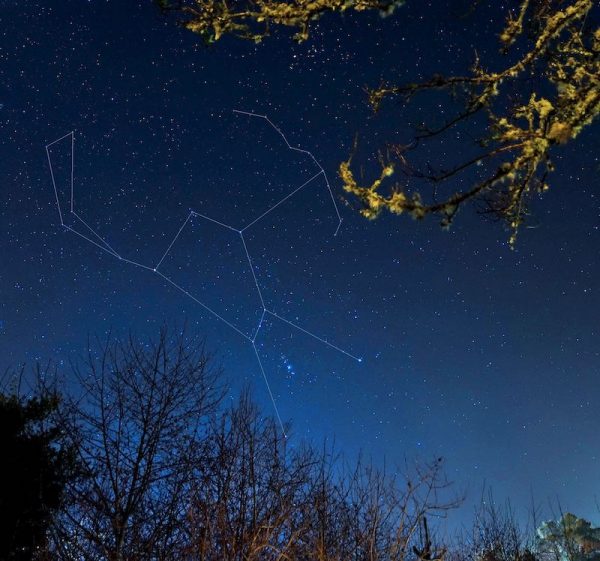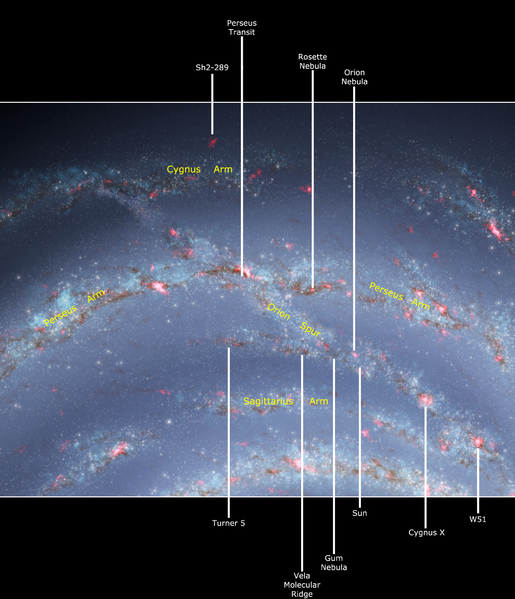
Tonight – or any winter evening – look for the constellation Orion the Hunter. It’s probably the easiest to pick out of all the constellations in the Northern Hemisphere winter sky (Southern Hemisphere summer sky). It’s identifiable by Orion’s Belt, three medium-bright stars in a short, straight row at the mid-section of the Hunter. Pick out any three equally bright stars in a row this evening, and you’ll probably be looking at Orion. Want to be sure? There are two even brighter stars – one reddish and the other blue – on either side of the Belt stars.
As seen from mid-northern latitudes, you’ll find Orion in the southeast at early evening and shining high in the south by mid-to-late evening (around 9 to 10 p.m. local time). If you live at temperate latitudes south of the equator, you’ll see Orion high in your northern sky around this hour.

View at EarthSky Community Photos. | Cecille Kennedy in Depoe Bay, Oregon, USA, captured this photo of the Orion constellation on January 15, 2021. She wrote: “Stars on a rare clear sky at the Oregon coast. I connected the stars of the constellation Orion The Hunter, based on the online constellation guide image.” Thank you, Cecille!
Notice the two brightest stars in Orion, Betelgeuse and Rigel. Rigel’s distance is estimated to be 773 light-years. The distance to Betelgeuse has been harder to determine. It’s currently estimated to be about 724 light-years away, but uncertainties remain.
Read more: How far is Betelgeuse?
Read more: What’s up with Betelgeuse? Is an explosion imminent?
Donate: Your support means the world to us

Our sun is located the Orion Arm, or Orion Spur, of the Milky Way galaxy. Several bright stars in Orion, including Rigel, Betelgeuse, the three stars in Orion’s Belt, and the Orion Nebula, also reside in the Orion Arm. Image updated in 2010 by R. Hurt on Wikimedia Commons.
Stars in distinct constellations like Orion look connected, perhaps even gravitationally bound. Usually, they aren’t.
But some of Orion’s most famous stars do have a general connection with one another. Several of the brightest stars in Orion are members of our local spiral arm, sometimes called the Orion Arm or sometimes the Orion Spur of the Milky Way. Our local spiral arm lies between the Sagittarius and Perseus Arms of the Milky Way. The image above shows it.
Now consider those three prominent Belt stars. They appear fainter than Rigel or Betelgeuse, but they’re farther away. They’re all giant stars in the Orion Arm. These stars’ names and distances are Mintaka (1,239 light-years), Alnilam (1,344 light-years), and Alnitak (1,262 light-years). When you look at these three stars, know that you’re looking across vast space, but into our local arm of the Milky Way galaxy.
Bottom line: At this time of year, the constellation Orion the Hunter takes center stage in the star-studded sky! It’s identifiable by Orion’s Belt, three medium-bright stars in a short, straight row at the mid-section of the Hunter.
Why do stars seem brighter in winter?
EarthSky lunar calendars are cool! They make great gifts. Order now. Nearly gone.
from EarthSky https://ift.tt/2ThriFs

Tonight – or any winter evening – look for the constellation Orion the Hunter. It’s probably the easiest to pick out of all the constellations in the Northern Hemisphere winter sky (Southern Hemisphere summer sky). It’s identifiable by Orion’s Belt, three medium-bright stars in a short, straight row at the mid-section of the Hunter. Pick out any three equally bright stars in a row this evening, and you’ll probably be looking at Orion. Want to be sure? There are two even brighter stars – one reddish and the other blue – on either side of the Belt stars.
As seen from mid-northern latitudes, you’ll find Orion in the southeast at early evening and shining high in the south by mid-to-late evening (around 9 to 10 p.m. local time). If you live at temperate latitudes south of the equator, you’ll see Orion high in your northern sky around this hour.

View at EarthSky Community Photos. | Cecille Kennedy in Depoe Bay, Oregon, USA, captured this photo of the Orion constellation on January 15, 2021. She wrote: “Stars on a rare clear sky at the Oregon coast. I connected the stars of the constellation Orion The Hunter, based on the online constellation guide image.” Thank you, Cecille!
Notice the two brightest stars in Orion, Betelgeuse and Rigel. Rigel’s distance is estimated to be 773 light-years. The distance to Betelgeuse has been harder to determine. It’s currently estimated to be about 724 light-years away, but uncertainties remain.
Read more: How far is Betelgeuse?
Read more: What’s up with Betelgeuse? Is an explosion imminent?
Donate: Your support means the world to us

Our sun is located the Orion Arm, or Orion Spur, of the Milky Way galaxy. Several bright stars in Orion, including Rigel, Betelgeuse, the three stars in Orion’s Belt, and the Orion Nebula, also reside in the Orion Arm. Image updated in 2010 by R. Hurt on Wikimedia Commons.
Stars in distinct constellations like Orion look connected, perhaps even gravitationally bound. Usually, they aren’t.
But some of Orion’s most famous stars do have a general connection with one another. Several of the brightest stars in Orion are members of our local spiral arm, sometimes called the Orion Arm or sometimes the Orion Spur of the Milky Way. Our local spiral arm lies between the Sagittarius and Perseus Arms of the Milky Way. The image above shows it.
Now consider those three prominent Belt stars. They appear fainter than Rigel or Betelgeuse, but they’re farther away. They’re all giant stars in the Orion Arm. These stars’ names and distances are Mintaka (1,239 light-years), Alnilam (1,344 light-years), and Alnitak (1,262 light-years). When you look at these three stars, know that you’re looking across vast space, but into our local arm of the Milky Way galaxy.
Bottom line: At this time of year, the constellation Orion the Hunter takes center stage in the star-studded sky! It’s identifiable by Orion’s Belt, three medium-bright stars in a short, straight row at the mid-section of the Hunter.
Why do stars seem brighter in winter?
EarthSky lunar calendars are cool! They make great gifts. Order now. Nearly gone.
from EarthSky https://ift.tt/2ThriFs

Aucun commentaire:
Enregistrer un commentaire